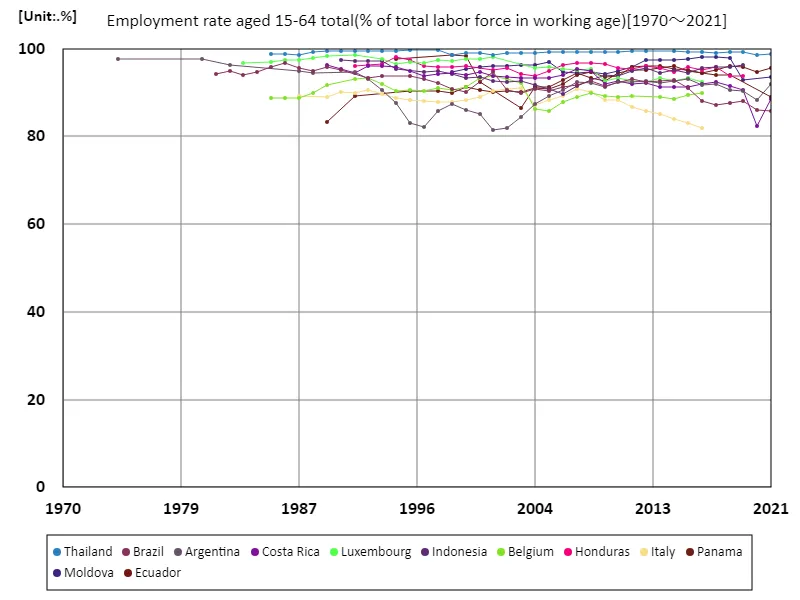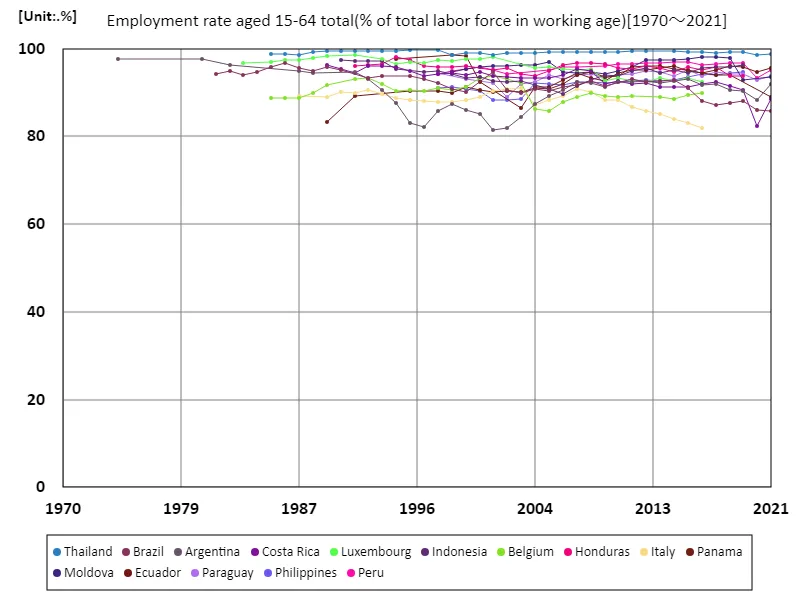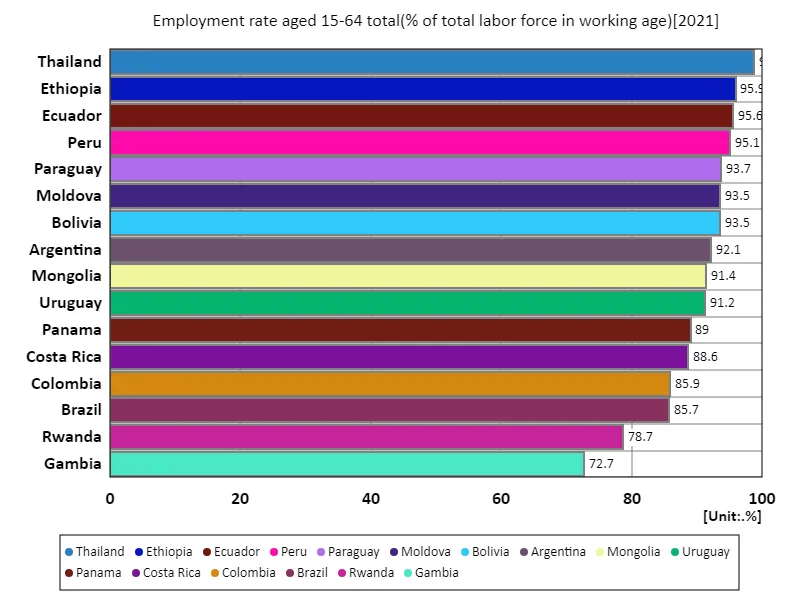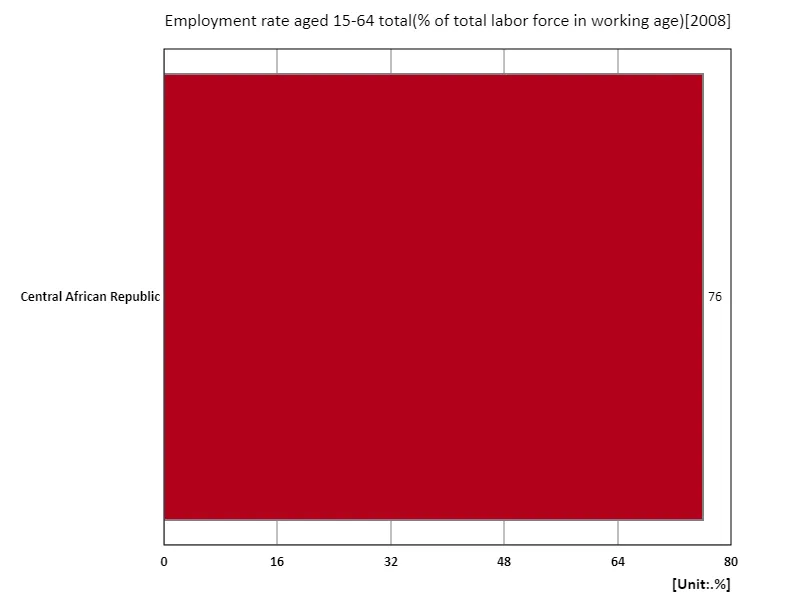- Abstract
- Employment rate for all 15-64 year olds (percentage of total labor force)
- Employment rate for all 15-64 year olds (percentage of total labor force) (worldwide)
- Employment rate for all 15-64 year olds (as a percentage of total labour force) (worldwide, latest year)
- Employment rate for all 15-64 year olds (% of total labour force) (region, latest year)
- Reference
Abstract
Thailand’s extremely high employment rate for 15-64 year olds in 2021, at 98.7%, suggests a unique economic feature. Generally, a high employment rate reflects a strong labor market and high demand for labor. But these numbers may not necessarily indicate a high standard of living or a healthy economy. For example, parts of Thailand’s labour market may contain a high proportion of non-regular and low-wage employment. Moreover, while employment rates are very high, we need to dig deeper into the impact on economic growth and quality of life. By taking into account not only the data but also the quality of employment and wage levels, we can get a more complete picture of Thailand’s economy.
Employment rate for all 15-64 year olds (percentage of total labor force)
Thailand is a particularly notable case when it comes to employment rates for 15-64 year olds in data from 1974 to 2021. In 1997, the employment rate hit an astoundingly high level of 99.7%, but has now fallen to 99%. There are several possible reasons for this. First, the high employment rate in 1997 reflects the robust labor market that accompanied Thailand’s period of economic growth, while subsequent fluctuations suggest the effects of economic transitions and external shocks. In particular, the 1997 Asian financial crisis had a serious impact on the Thai economy, causing fluctuations in the employment situation during the subsequent recovery process. In addition, Thailand’s very high employment rate is also due to the particularities of its labor market and the influence of informal sectors such as the agricultural sector. High employment rates do not necessarily mean higher quality of labor or higher income levels, especially in cases where there is a high prevalence of non-regular or low-wage labor. The slight decline in recent years may be due to structural changes in the economy, a maturing labor market, or global economic fluctuations. Overall, the trend in Thailand’s employment rate is an interesting indicator that reflects the country’s economic growth and changes in the labor market, and it is important to analyze it including qualitative aspects.


The maximum is 99.7%[1997] of Thailand, and the current value is about 99%
Employment rate for all 15-64 year olds (percentage of total labor force) (worldwide)
Looking back at data from 1974 to 2021, the highest employment rate for people aged 15 to 64 was 99.7%, achieved by Thailand in 1997. While this figure reflects Thailand’s rapid economic growth and booming job market, subsequent fluctuations are due to a number of factors. The 1997 Asian Financial Crisis had a significant impact on Thailand’s economy and labor market, but the country’s employment rate remained high, indicating the relative resilience of its labor market. The current decline in employment to 99% could reflect slower economic growth and structural changes in the labor market. In addition, Thailand’s labor market contains a large proportion of non-regular and low-wage employment, suggesting that a high employment rate does not necessarily mean improved working conditions or economic stability. It can be said that recent data is influenced by the maturation of Thailand’s economy and changes in global economic trends. Overall, Thailand’s employment rate trends are an important indicator for gaining a deeper understanding of its economic performance and changes in the labor market.


The maximum is 99.7%[1997] of Thailand, and the current value is about 99%
Employment rate for all 15-64 year olds (as a percentage of total labour force) (worldwide, latest year)
In 2021 data, Thailand recorded the highest employment rate for those aged 15-64 at 98.7%, with the overall average at 90.1% and the total at 1.44k%. Thailand’s high employment rate reflects the country’s robust labour market and broad-based economic activity. Thailand has maintained a high employment rate for many years, and this figure has been achieved despite the existence of a large proportion of non-regular and low-wage employment. The overall average employment rate of 90.1% is relatively high by global standards and indicates a strong labour market, especially in developing and emerging countries. However, a high employment rate does not necessarily mean a high standard of living or improved working conditions; the quality of the labor market and the level of wages are also important factors. The total figure of 1.44k% is the result of combining employment rates from several countries, providing a more holistic view when comparing data from individual countries. This total gives an indication of the breadth of the labour market from a global perspective and provides an understanding of the relative positions of labour markets in different countries. Overall, employment rate data are a valuable source of information for understanding the economic situation and labour market characteristics of each country, and analysis should take into account aspects such as job quality and wages.


The maximum is 98.7% of Thailand, the average is 90.1%, and the total is 1.44k%
Employment rate for all 15-64 year olds (% of total labour force) (region, latest year)
According to 2008 data, the Central African Republic had the highest employment rate for those aged 15-64 at 76%, with an overall average of 76% and a total of 76%. The high employment rate in the Central African Republic indicates the important role played by traditional industries, especially agriculture. While such high employment rates reflect an extensive and dynamic labour market, there may also be challenges in terms of job quality and working conditions, as the informal sector may be high. The overall average and total of 76% indicates a relatively balanced employment situation globally. The figures suggest a degree of consistency in economic and labor market conditions across countries. However, because regions have different levels of economic development and labor market conditions, simple averages may not provide the whole picture. As this data shows, while the employment rate is one indicator for understanding the economic situation and labor market characteristics of each country, it is also important to take into account the improvement in employment quality and working conditions.


The maximum is 76% of Central African Republic, the average is 76%, and the total is 76%



Comments